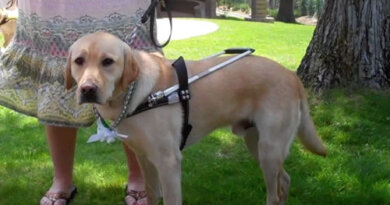Dog Tear Stains: What You Should Know
It’s frustrating to see rusty brown tear stains on your dog’s beautiful face. With so many tear-stain-removing products for sale in the pet supply stores, you may be tempted to buy one. But if your dog has watery eyes, before reaching for products that may help remove tear stains, please have your dog examined by a veterinarian. There are many conditions that can cause the eyes to water excessively which, left unaddressed, can result in pain and loss of vision.
The list of possible underlying issues is long. Some of the most common include allergies, inflammatory conditions (like conjunctivitis, corneal irritation, or ulcer), foreign bodies, glaucoma, distichiasis (eye lashes growing from the wrong place), entropion (eyelids that roll in so that haired skin rubs on the cornea), facial nerve paralysis (eyelids can’t blink), and nasolacrimal (tear duct) obstruction.
It should go without saying that if you notice any sign of pain or discomfort, such as a yellow or green discharge from the eyes, redness, itching, or pawing at the eyes, you should seek veterinary care as soon as possible.
If your veterinarian identifies an underlying medical issue that can be managed or corrected, tear staining will no longer be an issue. It’s also good news if no underlying issues are identified. Epiphora (excessive tears that overflow onto the face) is neither painful nor dangerous for your dog. It is simply a cosmetic issue. Sometimes simple changes in grooming habits will help.
GROOMING SOLUTIONS
If your dog has long hair on her face and near her eyes, keep this hair trimmed back. Long hairs rubbing on the eyes are very irritating. Long hairs around the eyes also wick tears down onto the face.
Cleanse your dog’s periocular (around the eyes) area at least once a day with a clean moist cloth or cotton ball. Eye-wash solutions containing boric acid are safe to use.
Rubbing a tiny amount of petroleum jelly onto the hair near the inside corner of the eye after cleansing can help keep the tears from penetrating the hair between cleanings, which helps minimizing staining.
HOME REMEDIES MIGHT WORK
As a veterinarian, I’ve heard about all sorts of things that some people do to try to reduce tear staining. Some people report success with things like adding buttermilk flour, parsley flakes, or apple cider vinegar to the dog’s food. Probiotics are purported to help with tear staining. Using Bausch + Lomb Renu contact lens solution for cleansing around the eyes has resulted in improvement.
Sometimes a simple diet change results in resolution of epiphora and tear staining. When this happens, it is likely the dog had an underlying allergy to some ingredient in his former diet.
The bottom line for all these home remedies: As long as they are not harmful to your dog, there is no harm in trying them. You’ll need to give anything you’re trying at least three months before expecting to see results. As always, your veterinarian is your best resource regarding the safety of anything you are thinking of trying.
AN OTC PRODUCT THAT WORKED

The most popular and widely known over-the-counter product for reducing tear stains is called Angels’ Eyes. Years ago, this product really worked, thanks to its active ingredient, an antibiotic called tylosin tartrate.
In 2014, the FDA cracked down on using this product for this purpose in dogs and cats, and the tylosin was removed from the Angels’ Eyes’ product formulations. In the opinion of many users, without tylosin, the product seemed less effective.
Today, Angels’ Eyes offers several supplements (in soft-chew and powdered form) that contain cranberry extract. The bioflavonoids in cranberry extract alter the ability of bacteria to stick to body tissues. I don’t know if it will reduce tear staining, but it should help alleviate the odor that sometimes comes along with the stains.
Angels’ Eyes also sells an external wipe, used to clean the area around the dog’s eyes. I prefer to use a clean damp cloth for this purpose.
Tetracycline is another antibiotic that has proven to be an effective treatment for tear staining, as it works via a number of mechanisms. Tetracycline biochemically breaks down the hydrostatic bonds in the dog’s tears, making the tears thinner and thereby better able to drain through the dog’s tiny tear ducts. It binds to iron, which is in porphyrin, the pigment responsible for tear staining. Tetracycline has also been found to diffuse into cells and alter the genetic expression of tear type and production.
The problem is, it’s an antibiotic – and antibiotic resistance is a real danger. Indiscriminate antibiotic use contributes to the development of “super bugs” that are resistant to common antibiotics. These resistant bacteria can cause life-threatening infections. When doctors have no effective treatment options, humans and animals die. With that moral and ethical issue on the table, the question becomes, is it appropriate to use an antibiotic for a purely cosmetic issue in dogs?
ASK YOUR VET
Talk to your veterinarian. If your dog has severe epiphora and tear staining, especially if it’s accompanied by odor and/or some underlying skin irritation, perhaps your veterinarian will prescribe tetracycline or tylosin to get the current problem under control. Improve your dog’s grooming, too: Keep the hair on his face trimmed away from his eyes and clean his face daily. Once the condition is controlled, you should be able to maintain his clean face using the grooming techniques and anecdotal suggestions mentioned above.
And don’t think all those people showing dogs know something you don’t know; they often cover the tear stains with chalk!





